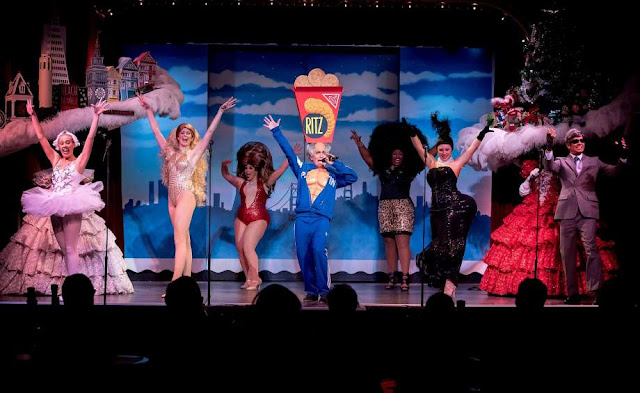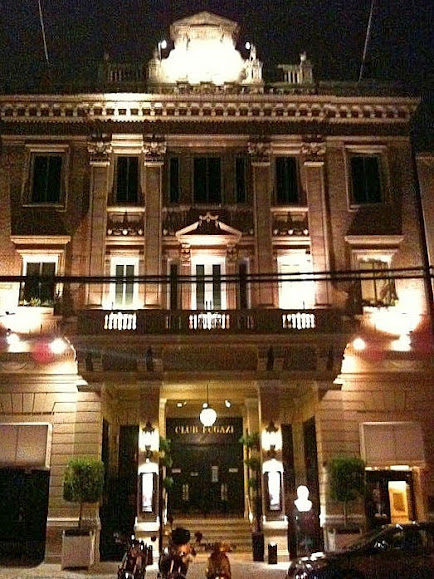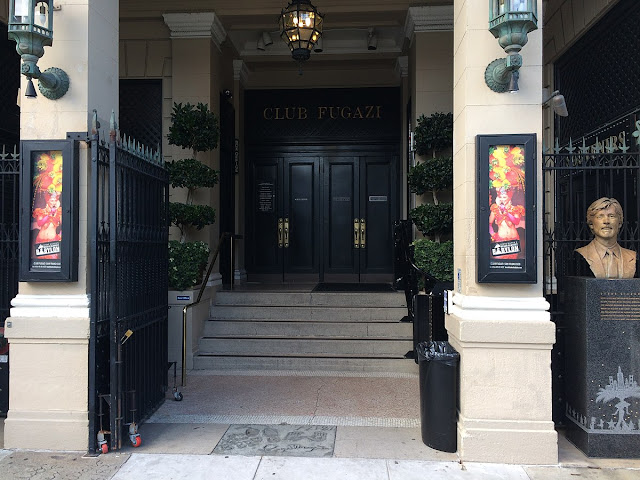Opened: The building opened in 1913 as an Italian community center called the Casa Coloniale Italiana John F. Fugazi, also known as Fugazi Hall. It's in North Beach on the north side of Green St. just west of Columbus. The photo by Tom Gray is from the Jack Tillmany collection. The banner in the entrance was advising that "Beach Blanket Babylon" had been temporarily moved to California Hall on Polk St. Jack notes that the show had moved for six weeks during the summer of 1981.
Website: www.clubfugazisf.com
Architect: Italo Zanolini. Harry Angus notes that other buildings by the architect include the Banca Popolare building at 2 Columbus Ave. (1906, most recently
occupied by Scientology), the building at 255
Columbus Avenue (1916, most recently occupied by Vesuvio Restaurant) and Fugazi's mausoleum chapel at the
Italian Cemetery in Colma.
Seating: 400. The nightclub/theatre space is on the ground floor, with a balcony that wraps around three sides of the space. There's also a lower floor of the building with interesting murals that had a long history as a dance hall.
History: The hall was financed by a donation from banker John F. Fugazi. He was the founder of Columbus Savings and Loan Society in 1893
and the Banca Popolare Operaia Italiana in 1906. Both later merged with
A.P. Gianini's Bank of Italy, later renamed the
Bank of America.
The building is owned and managed by Italian Community Services, a trust that was established in 1916. Phone: 415-362-6423. Website: www.italiancs.org On Facebook: www.facebook.com/italiancs.
Harry Angus comments on the project:
"Fugazi had promised to establish a community center for the Italian Colony of San Francisco following the earthquake and fire of 1906, but it wasn't until 1913 that the project began. Fugazi Hall was built in 1913 on a parcel of land donated by Fugazi's second wife, Joanna Fugazi.
"Barnum's Museum Will Open Tonight. Tonight a new playhouse will welcome San Francisco pleasure seekers. It is Barnum's Museum at 678 Green St. where 'The Drunkard' will be presented just as it used to be played some 90 years ago. Barnum's Museum is a complete innovation in theaters as it will place guests at tables instead of in the usual regimented seats, and beer and pretzels will be served free during the performance.
It was the Fugazi Theatre in 1933 and 1934. As Fugazi Hall it hosted performers including Pete Seeger and The Carter Family (1957), Jon Hendricks (1959), Thelonious Monk (1959, recording the album "Thelonious Alone in San Francisco") and Julian "Cannonball" Adderly (May 1960, recording his "Poll Winner" album). It was also used as a venue for readings by beat poets and others in the 50s and early 60s.
The Dead were onstage in 1967 for an album release party. In a post for the Facebook group SF Bay Area Memories Steve Williams comments:
Thanks to Jack Tillmany for locating this photo as well as many of the others appearing on this page.
An illustration advertising "Beach Blanket Babylon" that appeared in April 2019 with the show's closing notice on the BBB Facebook page. In a 45 year run there were 17,216 performances with a total attendance of 6.5 million.
The "BBB" closing: "Beach Blanket Babylon" closed December 31, 2019.
Status: The 7 Fingers show "Dear San Francisco" has been running since September 2021. An anonymous tipster notes:
"The space was significantly restored for this show and it's now
home to that show (an acrobatic love letter to San Francisco) and
things like 'Sunday's A Drag' drag brunch, a speaker series, and live
music."
Interior views:
A proscenium view during the run of "Beach Blanket Babylon." Photographer: unknown
A look to house right. Photographer: unknown
A pre-show balcony view. Photographer: unknown
A "Beach Blanket Babylon" scene. Photographer: unknown
A "BBB" 60s tribute. Photographer: unknown
Another "BBB" scene. Photographer: unknown
Thanks to Jack Tillmany for this photo from his collection. It appears on page 63 of his Arcadia Publishing book "Theatres of San Francisco." The page with the photo is included with the preview on Google Books.
The bust of Steve Silver (1944-1995) to the right of the entrance. Photographer: unknown
Above the entrance doors. Photographer: unknown
The Green St. sign. Photographer: unknown
Jack Tillmany's Arcadia Publishing book "Theatres of San Francisco" can be previewed on Google Books. It's available from Amazon or your local bookseller.
| back to top | San Francisco Theatres: by address and neighborhood | alphabetical list | list by architect | pre-1906 theatre list | home |



























Is anyone still updating this site? The 7 Fingers' Dear San Francisco has been running here since September of 2021. The space was significantly restored for this show and it's now home to that show (an acrobatic love letter to San Francisco) and things like Sunday's A Drag drag brunch, a speaker series, and live music. www.clubfugazisf.com
ReplyDeleteThanks for the update. I added it to the text. Cheers!
DeleteAny chance you can update that the building is owned and operated by Italian Community Services (a nonprofit) founded in 1916? ICS has been trustee of the building known as Casa Fugazi since 1961. The website is: www.italiancs.org Grazie!
ReplyDeleteWell, I already had most of that up near the top of the page. Here''s what I had: "The building is owned and managed by Italian Community Services, a trust that was established in 1916. Phone: 415-362-6423. On Facebook: www.facebook.com/italiancs." I'll add the website. Cheers!
Delete